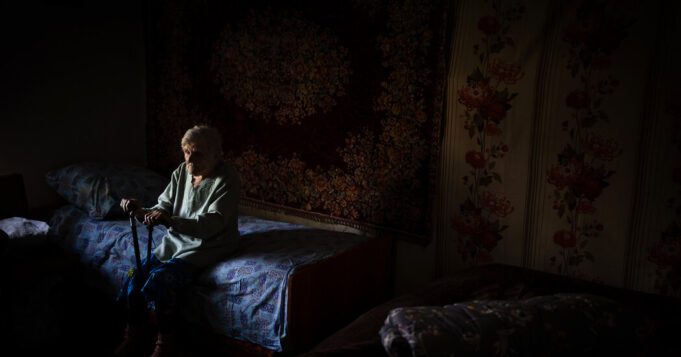When a Russian soldier showed up outside the destroyed home of 98-year-old Lidiia Lomikovska in eastern Ukraine in late April, the first thing he did was shoot and kill the family dog.
“What did you do?” her daughter-in-law, Olha, 66, shouted at the Russian. “He was protecting me.”
“Now, I will protect you,” he told her, Olga recalled in an interview.
Ms. Lomikovska – lived through the famine planned by Stalin Millions died in the 1930s and the German occupation of her town of Auchrettine during World War II. She said she didn't know why her life had been so clouded by sadness.
But when war came to her doorstep again, she knew she did not want to live under Russia’s “protection.”
As shells exploded around town, she was separated from her family in the chaos. So she set out on foot, alone. For hours, she walked past the bodies of dead soldiers and stumbled across bomb craters in a pair of slippers, without food or water, not knowing if her next step would be her last.
“I was walking along the road and there was no one, only the sound of gunfire, and I wondered if they were shooting at me,” she said in an interview. “I was walking and crossing myself, thinking, if only the war would end, if only everything would stop.”
But the war is not over, and Russia's continued offensive on the Donetsk region threatens to subject the half-million civilians in Ukrainian-controlled areas to even more intense bombing.
Meanwhile, Russian forces have recently opened new offensive routes outside Kharkiv in the northeast, and Ukrainian officials have warned that Moscow could try to cross the border into the city of Sumy, opening another front in the north. More than 20,000 people have been evacuated from the Sumy and Kharkiv regions in recent weeks. Ukrainian officials said At the end of May.
The Russian advance was slow and bloody, with each advance a town, village or settlement was reduced to ruins.
“It's terrible, like hell, when you come to a settlement everything nearby is burning, these guided air shells have completely destroyed houses, multi-story buildings and private homes,” said Pavlo Diachenko, 40, a police officer with the White Angels, a group working to evacuate civilians from areas most at risk.
Last month, the group travelled around the Donetsk region helping 10 to 20 people every day.
“People didn’t even have a chance to bring anything — they just had a bag with luggage or a small purse,” he said.
Currently, Russian troops are mainly besieging relatively small villages and towns, many of which are already largely deserted.
But as the front lines shift, hundreds of thousands of civilians in towns in the Donbas region that remain under Ukrainian control are watching the situation nervously.
In February, Ukrainian officials said at least 1,852 civilians were killed and another 4,550 injured in the Donetsk region, part of the Donbass region, during the war.
By May 10, Already rising The local government said the death toll reached 1,955 and the number of injured reached 4,885.
Ukrainian officials, human rights investigators and United Nations observers say those figures are likely to be a significant underestimate of the death toll, and there is still no internationally published figure on the exact number of civilian deaths in Russian-occupied territories.
For Mr. Diachenko, persuading people to evacuate is often a challenge and sometimes ends in tragedy.
“When you come and talk to people about the need to evacuate, and the next day you come to pick them up only to find that they have died from shelling,” Mr. Diachenko said. “That is probably the most painful thing for each of us.”
In the months when the front lines remained relatively stable, many of those who had fled before all-out war returned home, believing the risks were manageable and that a deep attachment to their homeland was enough to offset them.
The most dangerous place in Ukraine is within range of artillery and drone fire from both sides of the front line. This area extends about 20 miles in both directions from the front line, and the violence increases the closer the two armies are to the battle.
The earth was covered with craters like the surface of the moon, the continuous bombardment had left the bodies uncollected for months, the shadow of death hung in the sky, drones tracked everyone who moved. Mortars, mines, missiles, bombs exploded day and night.
Even the slightest shift in the front line could result in the destruction of new villages.
Sergey Bahri, mayor of the village of Bohorodichny in Donetsk Oblast, knows all too well what happens when fighting spreads to a new town.
“In 2022, a bomb hit my house, and we miraculously survived in the basement,” he said. “It was horrible. Everything was burning. Everything was red. I remember there was no oxygen. I tried to breathe, but there was no oxygen.”
In Bohorodich, only 29 of 700 residents have returned, he said.
There is no electricity or running water. Beyond the ruined homes, rolling hills stretch for miles of dragon teeth, pyramid-shaped concrete spikes used to trap tanks. People there rely mainly on small, well-tended gardens and food, water and medicine brought in by volunteers and a sanitation trailer donated by an American Mormon for bathing and washing clothes.
Still, Mr. Bahri said there was hope that the U.S. weapons shipments would deter the Russians from entering the region again.
“There is hope, but it’s not certain,” he said.
Many of the escapees did not go far, choosing to stay in cities around Donbass to be close to their lands, which would be threatened if the Russians managed to pull off a major offensive, he said.
“It’s unlikely that anyone will stay,” he said. “These people already know what it’s like to explode, blow up and die.”
Ms. Lomikovska, 98, doesn’t want to leave. Even as fighting intensifies near her home, she works hard to tend her garden — growing potatoes, onions, garlic and herbs.
Born in 1926 when the Great Famine ravaged the land, she knows what it is like to live without food. Her fertile plot of land is a lifeline that she carefully nurtures, no matter how dangerous the surroundings may be, her family said.
“When I was a kid, life was hard and we had nothing to eat,” Ms. Lomikovska said. “We survived on what we grew in the garden.”
She was already a teenager in 1941 when the Germans occupied her village.
“I wasn’t scared at the time,” she said. Even though German soldiers slept in her family’s house, she said, “they didn’t move a thing.”
She and her husband raised two sons in the house they built in Ochretan, and she also worked long hours as a railway carriage steward, caring for passengers. Her husband and youngest son died before the war turned her world upside down again.
She recalled the fear of those last sleepless nights before the Russians took her town in April.
“I wasn't lying lengthwise in bed, I was lying sideways,” she said. “I pulled my legs in towards me. My bed was next to the window, and there was nothing covering the window. If we had blocked the window with something, they would have broken it. And it was very windy. It was cold. I was lying there and I heard the gunshots.”
She now lives with her granddaughter. Chasif YarThe hilltop town was razed to the ground when Russian troops tried to capture it.
If Russian troops succeed in capturing Chasiv Yar — halting Russia’s current siege of the Donetsk region’s main population centre — Ms Lomikovska knows she may have to flee again.
“Now,” she said, “I don’t know where else to go.”









